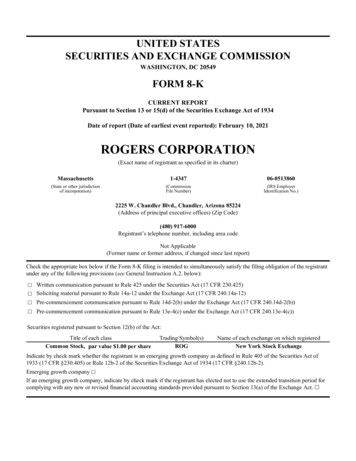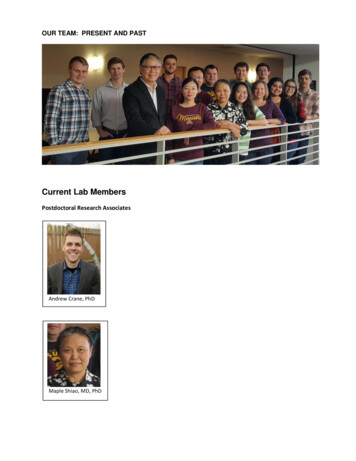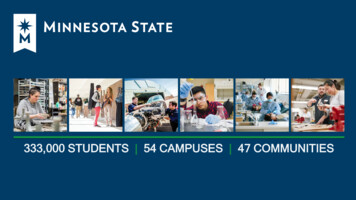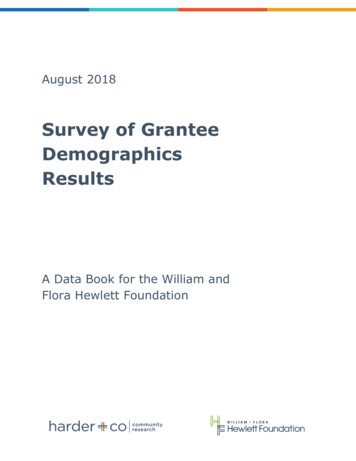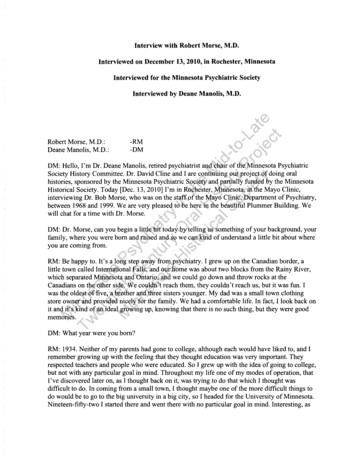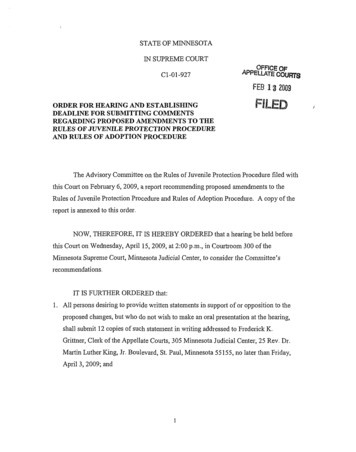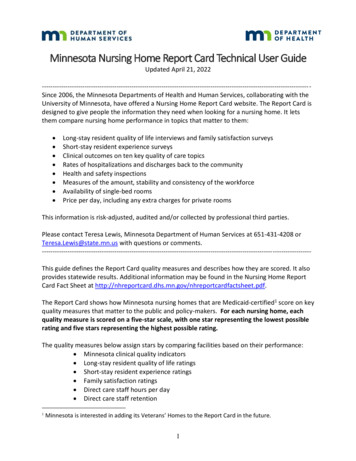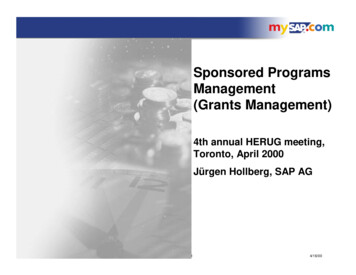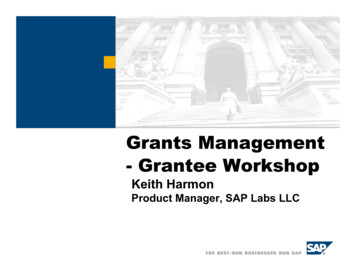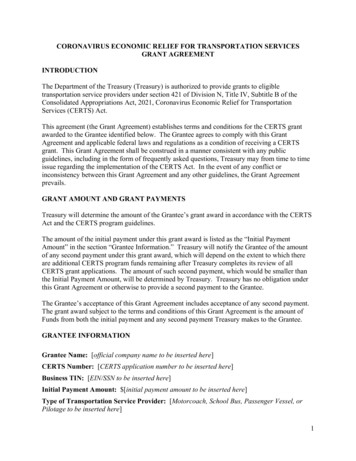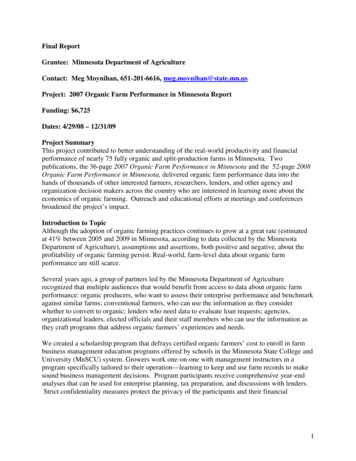
Transcription
Final ReportGrantee: Minnesota Department of AgricultureContact: Meg Moynihan, 651-201-6616, meg.moynihan@state.mn.usProject: 2007 Organic Farm Performance in Minnesota ReportFunding: 6,725Dates: 4/29/08 – 12/31/09Project SummaryThis project contributed to better understanding of the real-world productivity and financialperformance of nearly 75 fully organic and split-production farms in Minnesota. Twopublications, the 36-page 2007 Organic Farm Performance in Minnesota and the 52-page 2008Organic Farm Performance in Minnesota, delivered organic farm performance data into thehands of thousands of other interested farmers, researchers, lenders, and other agency andorganization decision makers across the country who are interested in learning more about theeconomics of organic farming. Outreach and educational efforts at meetings and conferencesbroadened the project’s impact.Introduction to TopicAlthough the adoption of organic farming practices continues to grow at a great rate (estimatedat 41% between 2005 and 2009 in Minnesota, according to data collected by the MinnesotaDepartment of Agriculture), assumptions and assertions, both positive and negative, about theprofitability of organic farming persist. Real-world, farm-level data about organic farmperformance are still scarce.Several years ago, a group of partners led by the Minnesota Department of Agriculturerecognized that multiple audiences that would benefit from access to data about organic farmperformance: organic producers, who want to assess their enterprise performance and benchmarkagainst similar farms; conventional farmers, who can use the information as they considerwhether to convert to organic; lenders who need data to evaluate loan requests; agencies,organizational leaders, elected officials and their staff members who can use the information asthey craft programs that address organic farmers’ experiences and needs.We created a scholarship program that defrays certified organic farmers’ cost to enroll in farmbusiness management education programs offered by schools in the Minnesota State College andUniversity (MnSCU) system. Growers work one-on-one with management instructors in aprogram specifically tailored to their operation—learning to keep and use farm records to makesound business management decisions. Program participants receive comprehensive year-endanalyses that can be used for enterprise planning, tax preparation, and discussions with lenders.Strict confidentiality measures protect the privacy of the participants and their financial1
information. The scholarships start at 80% of tuition and decrease by 10% every two semestersthereafter.1When our team designed the larger project, we did not anticipate a need for or interest in anannual report summarizing participant data. A 2006 performance report was produced with onetime funding by the Minnesota Department of Agriculture and it proved to be very popular withparticipating farmers, instructors, and others curious about organic performance. Our teamwanted to produce print and electronic versions of a 2007 data reportObjectives StatementWe requested 6,725 in OFRF funds to write, print, and disseminate a 32 to 40 page bookletcontaining 2007 data from 70 to 80 organic farmers enrolled in Minnesota’s Farm BusinessManagement (FBM) program.These discrete objectives fit into a larger purpose: to collect accurate, real-world production andfinancial information generated by working organic farms and get it into the hands of farmersand other decision makers. The larger project has been funded by USDA Risk ManagementAgency since 2006. It has involved modifying financial analysis software for organic enterprisesand recruiting and enrolling farmers to work with farm business management instructors.Materials and MethodsIn spring 2008, individual FBM instructors submitted their data to the University of MinnesotaCenter for Farm Financial Management (CFFM) where it was checked for errors, stripped ofidentifying characteristics, and incorporated into a 2,000 farm database called FINBIN.Project Manager Meg Moynihan and project partners Dale Nordquist (CFFM) and RonDvergsten (MnSCU) discussed and determined what kinds of whole farm and enterprise-levelfinancial tables to include in the publication. The CFFM produced these data tables and Dalewrote an introduction/overview. Ron provided information about financial measures that weincluded in the publication to help users benchmark their own farm information.The book included 25 tables containing whole farm and crop and dairy enterprise analyses fororganic producers and some comparisons to conventional farms. Data were provided by 45fully organic farms and 20 farms using both organic and conventional management (splitproduction farms) for a grand total of 65 operations.Staff at the Minnesota Department of Agriculture provided graphic and layout services andadded all partner logos. After a bidding process, 1,000 copies of the 36-page 2007 Organic FarmPerformance in Minnesota was sent to press.Copies of the book were distributed free of charge to groups and individuals listed in Appendix 1and by project partners (Organic Crop Improvement Association, MN #1, Sustainable FarmingAssociation of Minnesota, University of Minnesota Center for Farm Financial Management).Other outreach activities are detailed in the Outreach section below.1In 2009, the average annual cost of Farm Business Management program tuition was about 1,400/year.2
Cost savings in production meant that, with OFRF’s permission, we could stretch the funds to anadditional year, producing a 2008 Organic Farm Performance in Minnesota book as well. Workon that began in Spring 2009. We used the same procedure as in 2008 and, along with Dale’sintroductory analysis, added contributions by two farm business management instructors:“Valuing a Lifestyle: Using Numbers to Inform Big Picture Thinking,” “How to Use this Book”and “Getting the Most out of Your Own Farm Analysis – A Step by Step Guide for ParticipatingFarmers.” Additional definitions of farm financial management terms and measures were addedas well. We printed 1,500 copies of 2008 Organic Farm Performance in Minnesota.The 2008 book includes 28 tables containing whole farm and crop and dairy enterprise analysesfor organic producers and some comparisons to conventional farms. Data were provided by 48fully organic farms and 26 farms using both organic and conventional management for a grandtotal of 74 operations.In addition to the print versions, electronic PDF copies of the book (or links to it) were posted onevery partner’s web site:2007 Organic Farm Performance in Minnesota od/organicgrowing/2007orgfarmperf.pdf2008 Organic Farm Performance in Minnesota od/organicgrowing/2008orgfarmperf.pdfProject ResultsThis project resulted in two publications (one planned and one “bonus”) that summarized anddelivered two years of Minnesota organic farm performance data to more than a thousand peopleeach year (enclosed with addenda).Participating FBM instructors reported that they used the books to help their individual studentsbenchmark their own farm performance against that of their peers.Publicity about the books (and their electronic versions) and outreach/education activities atmeetings and conferences further broadened awareness of the publications and, more broadly,the economics of organic farming. A Google search for the title "organic farm performance inMinnesota” nets 1,070 hits (Appendix 2).Conclusions and DiscussionThis project has had an immense reach, delivering concrete information about how organicfarming “works,” in terms of farm performance and economics, to several thousand individualsand organizations. It enhanced a larger simultaneous effort to increase farm businessmanagement capacity of organic farmers while systematically collecting data about theproductivity, costs, and profitability of organic farming in Minnesota. In addition to deliveringdata, the books also proved to be an important advertising tool for the larger project and, wehope, stimulated interest beyond Minnesota in quantifying the economics of organic farming.3
Data from future years of the project will continue to be available to www.finbin.umn.edualthough not in the organized, packaged, analysis-enhanced and conveniently delivered form ofthe 2007 and 2008 publications.OutreachIn addition to direct mailing the publications to individuals detailed in Appendices 1 and 2, thebooks were publicized and distributed in a variety of ways: Via press release (Appendix 3) distributed to more than 100 print and radio media throughoutthe state of Minnesota, certifying agencies, and to organic/sustainable agriculture listservsand organizations (Appendix 4). More than 150 individuals have contacted the MDA torequest print copies. Featured in displays at meetings, conferences and workshops, including:o University of Minnesota Organic Field Day (June 2008, 2009)o University of Minnesota Extension Small Farm and Rural Living Expo (September 2008,2009)o Albert Lea Seed House Organic Workshop (November 2008)o Minnesota Organic Conference (January 2009)o Midwest Value Added Conference (January 2009)o Upper Midwest Organic Farming Conference (February 2009)o Sustainable Farming Association of Minnesota Annual Conference (February 2009)o Minnesota Farmers Union Annual Conference (November 2009)o Minnesota Farm Bureau Annual Conference (November 20009) In a special session “Using and Understanding Farm Financial Indicators” at the 2009Minnesota Organic Conference (where OFRF support was specifically acknowledged). In presentations at the 5th National Small Farms Conference and at a pre-conference shortcourse about farm financial management (September 2009) (Proceedings not yet published)PowerPoint 4
AddendaAppendix 1. Distribution via direct mail and distributionAll participating farmersAll other certified organic farmers in MNAll Minnesota Farm Business Management Instructors ( 80)Farm Business Management Deans7th District Federal ReserveAccredited Certifiers AssociationACRESAgriculture Utilization Research InstituteAll FSA Minnesota field offices5
Appendix 2. Web penetration6
Appendix 3. Sample press release7
Appendix 4. Publicity about the publications to regional and national organic andsustainable organizations and listservsATTRA/NCATEconomic Development Association ofMinnesotaFarm Beginnings ProgramFarm Credit Services: AgStar, United, andNorthernFive Extension educators in MinnesotaFood AllianceIndependent Community BankersAssociation of MinnesotaIndependent Organic Inspectors AssnLand Stewardship ProjectMidwest Organic and Sustainable EducationServicesMidwest Sustainable Agriculture WorkingGroupMinnesota Farm BureauMinnesota Association of CommunityBankersMinnesota Association of Soil and WaterConservation DistrictsMinnesota Farmers UnionMinnesota Food AssociationMinnesota Fruit and Vegetable GrowersAssn.Minnesota GrownMinnesota Milk Producers AssociationMinnesota Organic Advisory Task ForceMembersMinnesota Organic Memorandum ofUnderstanding signatory agencies(Minnesota NRCS, FSA, RMA, and RuralDevelopment offices, Minnesota PollutionControl Agency, Minnesota Department ofNatural Resources, University of MinnesotaCollege of Food, Agriculture and NaturalResources Sciences, University ofMinnesota Extension, University ofMinnesota Agricultural Experiment Station)Minnesota Organic Network ListservMinnesota Sustainable Agriculture ListservMN Congressional Representatives - 8House DistrictsNational Agriculture LibraryNational Association of State Departmentsof AgricultureNational Association of State OrganicPrograms board membersNorthern Plains Sustainable AgricultureSocietyOrganic certifiers operating in Minnesota(20)Organic Farming Research FoundationOrganic Trade AssociationOrganic ValleyRodale/New FarmMinnesota Senators Al Franken and AmyKlobucharSustainable Agriculture Research andEducation ProgramSustainable Farming Association ofMinnesota (SFA)University of Georgia AgriculturalEconomist Luanne LohrUniversity of Minnesota researchers with ademonstrated interest in organic topics (asreference materials for National Institute ofFood and Agriculture funding proposals,etc.)USDA-Agricultural Marketing Service,Livestock and Grain Market NewsUSDA-Economic Research Service8
Contact: Meg Moynihan, 651-201-6616, meg.moynihan@state.mn.us Project: 2007 Organic Farm Performance in Minnesota Report Funding: 6,725 Dates: 4/29/08 - 12/31/09 Project Summary This . Organic Farm Performance in Minnesota, delivered organic farm performance data into the hands of thousands of other interested farmers, researchers, .
